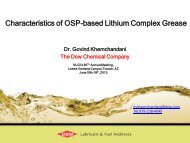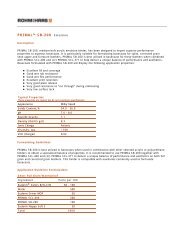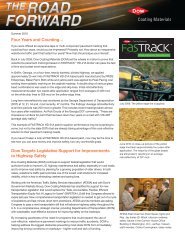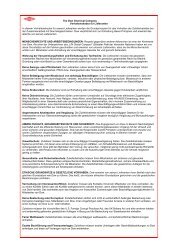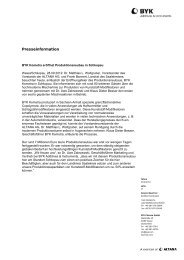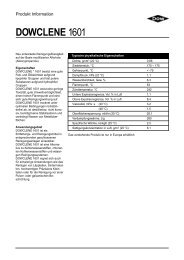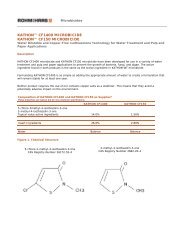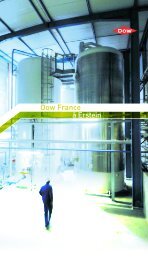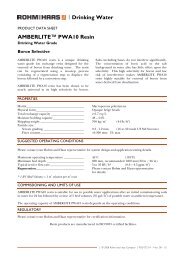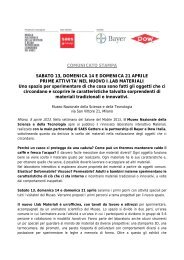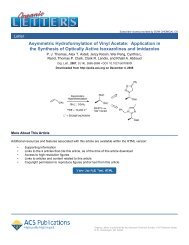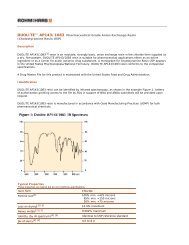Acrysol TT-615--Technical Data Sheet - The Dow Chemical Company
Acrysol TT-615--Technical Data Sheet - The Dow Chemical Company
Acrysol TT-615--Technical Data Sheet - The Dow Chemical Company
You also want an ePaper? Increase the reach of your titles
YUMPU automatically turns print PDFs into web optimized ePapers that Google loves.
ACRYSOL <strong>TT</strong>-<strong>615</strong> Rheology Modifier<br />
Description<br />
ACRYSOL <strong>TT</strong>-<strong>615</strong> is a hydrophobically modified anionic thickener, designed to give a very pseudoplastic profile in<br />
interior/exterior latex paints.<br />
ACRYSOL <strong>TT</strong>-<strong>615</strong> provides paints with high in-can structure and is ideal for use with thickeners designed to give<br />
high shear viscosity; to achieve the desired balance between sag and levelling properties. ACRYSOL <strong>TT</strong>-<strong>615</strong><br />
exhibits viscosity build comparable to high molecular weight HEC thickeners at low shear levels (see Graph 1). It<br />
demonstrates better roller spatter resistance than the cellulosics. ACRYSOL <strong>TT</strong>-<strong>615</strong> has a very pseudoplastic<br />
rheological profile (see Graph 3) ideal to reduce settling tendencies in the paint.<br />
Delivered as a low viscosity liquid, ACRYSOL <strong>TT</strong>-<strong>615</strong> is very easy to handle and incorporate into the paint. It is<br />
resistant to microbiological degredation, thereby avoiding viscosity loss in the paint, one of the most common<br />
problems encountered by paint manufacturers.<br />
ACRYSOL <strong>TT</strong>-<strong>615</strong> develops viscosity by neutralisation to a pH of 7.0-10.0 (see Graph 2).<br />
Characteristics<br />
� Delivers high in-can structure<br />
� Excellent sag resistance<br />
� Imparts non settling properties<br />
� Resistant to microbe and enzyme attack<br />
� Easy to incorporate<br />
� Ideal for viscosity adjustments as a post addition<br />
Typical Properties<br />
<strong>The</strong>se properties are typical but do not constitute specifications.<br />
Appearance Off white milky liquid<br />
Solids Content % 30<br />
Brookfield Viscosity (1 at 60) Max 26 cps<br />
Specific gravity (wet polymer) 1.06<br />
Solvent Water<br />
Chemistry HASE*<br />
pH 2.2 - 2.3<br />
* Hydrophobically modified alkali swellable emulsion
Graph 1: Thickener Viscosity Development in Water
Graph 2: Viscosity versus Percent Neutralization and pH
Graph 3: Viscosity/Shear Rate Profile of Thickeners in Water<br />
Formulations<br />
Formulations Guidelines:<br />
Incorporation<br />
ACRYSOL <strong>TT</strong>-<strong>615</strong> associative thickener offers the latex paint manufacturer easy handling and flexibility in both the<br />
order of addition and the method of incorporation compared to cellulosics and hydrophobically modified cellulosic<br />
thickeners. It can be added to the millbase, to the letdown, or as a post addition without affecting performance<br />
properties, as long as the medium is sufficiently alkaline during the incorporation and sufficient mixing is available.<br />
Supplied as a low viscosity emulsion, ACRYSOL <strong>TT</strong>-<strong>615</strong> is easy to pump or pour and therefore very suitable for<br />
bulk handling and/or automatic metering equipment.<br />
Order of Addition<br />
As stated above, ACRYSOL <strong>TT</strong>-<strong>615</strong> can be incorporated at different stages of formulation, provided that enough<br />
base is available to neutralise the thickener and additional base is used to adjust pH. <strong>The</strong>se stages are (1) as the<br />
final letdown ingredient, (2) after dispersion but prior to letdown or (3) prior to pigment dispersion. In all cases it<br />
is recommended to add ACRYSOL <strong>TT</strong>-<strong>615</strong> diluted 1:1 with water.<br />
Adding ACRYSOL <strong>TT</strong>-<strong>615</strong> as one of the final ingredients in the letdown is convenient in the laboratory to determine<br />
the approximate amount of thickener that will be needed to achieve the desired viscosity, or in the plant to make<br />
final viscosity adjustments. Addition of ACRYSOL <strong>TT</strong>-<strong>615</strong> in this manner assumes reasonably good agitation in the<br />
vessel. Less than ideal mixing can be compensated for, in many cases, by adding the thickener emulsion more<br />
slowly. In any case, the addition of the appropriate amount of base prior to the ACRYSOL <strong>TT</strong>-<strong>615</strong> is essential in<br />
order to avoid reduction in pH and subsequent pigment flocculation.
ACRYSOL <strong>TT</strong>-<strong>615</strong> can also be added during the letdown stage in a preneutralised form:<br />
Solution Preparation<br />
Safe Handling Information<br />
Weight (%)<br />
Water 92.7<br />
Ammonia 28% 0.7<br />
ACRYSOL <strong>TT</strong>-<strong>615</strong> 6.6<br />
Total 100.0<br />
This solution should be adjusted to a pH of between 8.0 and 8.5.<br />
Rohm and Haas <strong>Company</strong> maintains comprehensive and up-to-date Material Safety <strong>Data</strong> <strong>Sheet</strong>s (MSDS) on all of<br />
its products. <strong>The</strong>se sheets contain pertinent information that you may need to protect your employees and<br />
customers against any known health or safety hazards associated with our products.<br />
Rohm and Haas <strong>Company</strong> recommends that you obtain copies of our Material Safety <strong>Data</strong> <strong>Sheet</strong>s from your local<br />
Rohm and Haas representative on each of our products prior to its use in your facilities. We also suggest that you<br />
contact your supplier of other materials recommended for use with our products for appropriate health and safety<br />
precautions prior to their use.<br />
ACRYSOL, AVANSE, DRYCRYL, ELASTENE, FASTRACK, KATHON, LIPACRYL, MAINCOTE, OROTAN, PARALOID, PRIMAL, QUICK SET, ROPAQUE,<br />
ROVACE and SKANE are trademarks of Rohm and Haas <strong>Company</strong>, Philadelphia USA.<br />
<strong>The</strong>se suggestions and data are based on information we believe to be reliable. <strong>The</strong>y are offered in good faith, but without guarantee, as<br />
conditions and methods of use of our products are beyond our control.<br />
We recommend that the prospective user determines the suitability of our materials and suggestions before adopting them on a commercial<br />
scale.<br />
Suggestions for uses of our products or the inclusion of descriptive material from patents and the citation of specific patents in this<br />
publication should not be understood as recommending the use of our products in violation of any patent or as permission or license to use<br />
any patents of the Rohm and Haas <strong>Company</strong>.<br />
For further details, please contact your local Account Manager or local Business Representative.<br />
©Rohm and Haas, 2007 All rights reserved. September 2005



